|
|
|
Sort Order |
|
|
|
Items / Page
|
|
|
|
|
|
|
| Srl | Item |
| 1 |
ID:
077132
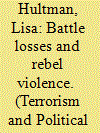

|
|
|
|
|
| Publication |
2007.
|
| Summary/Abstract |
In many armed conflicts, rebel groups deliberately target civilians. This article examines whether such violence is related to the performance of the rebels on the battlefield. It is proposed that rebel groups who are losing battles target civilians in order to impose extra costs on the government. When rebels attack civilians, the government may incur both political and military costs. Violence against civilians is thus used as an alternative conflict strategy aimed at pressuring the government into concessions. The argument is evaluated by using monthly data for rebel groups involved in armed conflict from January 2002 to December 2004.
|
|
|
|
|
|
|
|
|
|
|
|
|
|
|
|
| 2 |
ID:
153626
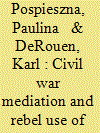

|
|
|
|
|
| Summary/Abstract |
Violence against civilians is portrayed as an antecedent of civil war, a cause, or both. Civil war creates opportune environments for planning and carrying out these acts that in turn can have detrimental effects on peace processes. Since not all civil war factions will see peace as beneficial, some actors may use violence to undermine the peace talks. The rebels may use indiscriminate violence to demonstrate their ability to exact costs on the government thus forcing the latter to negotiate. This article focuses upon acts of violence committed by rebel groups during mediated peace process. The central hypothesis is that violence against civilians increases the probability of mediation that in turn increases the prospects for violence. Using all civil war episodes from 1970 to 2008 as observations results from bivariate probit analysis endogenizing the choice of mediation bear out this theoretical argument.
|
|
|
|
|
|
|
|
|
|
|
|
|
|
|
|
| 3 |
ID:
111890


|
|
|
|
|
| Publication |
2012.
|
| Summary/Abstract |
Theories and counterinsurgency doctrines emphasize the importance of avoiding civilian casualties. Yet, many operations produce large numbers of so-called collateral civilian deaths. I present two competing arguments for when collateral deaths occur. One the one hand, they could be the unintentional result of offensives when trying to maintain force protection; on the other hand, they could be the result of a deliberate choice of relying on indiscriminate violence when pressured on the battlefield. I use new data on violence in Afghanistan 2004-2009, disaggregated by province and month, to examine what type of battlefield dynamics are more likely to produce high levels of collateral civilian casualties. The results show that civilian casualties are particularly high after counterinsurgency forces suffer losses in combat.
|
|
|
|
|
|
|
|
|
|
|
|
|
|
|
|
| 4 |
ID:
184199
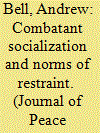

|
|
|
|
|
| Summary/Abstract |
Can armed groups socialize combatants to norms of restraint – in essence, train soldiers to adopt norms of international humanitarian law on the battlefield? How can social scientists accurately measure such socialization? Despite being the central focus of organizational and ideational theories of conflict, studies to date have not engaged in systematic, survey-based examination of this central socialization mechanism theorized to influence military conduct.
This study advances scholarly understanding by providing the first comparative, survey-based examination of combatant socialization to norms of restraint, using surveys and interviews with US Army cadets at the US Military Academy (USMA), Army Reserve Officer Training Corps (ROTC), and active duty Army combatants. Additionally, to better understand ‘restraint’ from combatants’ perspective, this study introduces the concept of the ‘combatant’s trilemma’ under which combatants conceptualize civilian protection as part of a costly trade-off with the values of military advantage and force protection.
Survey results hold both positive and negative implications for socialization to law of war norms: military socialization can shift combatants’ preferences for battlefield conduct. However, intensive norm socialization may be required to shift combatants’ preferences from force protection to civilian protection norms. Study findings hold significant implications for understanding violence against civilians in conflict and for policies to disseminate civilian protection norms in armed groups worldwide.
|
|
|
|
|
|
|
|
|
|
|
|
|
|
|
|
| 5 |
ID:
147832
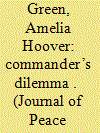

|
|
|
|
|
| Summary/Abstract |
This article proposes a framework for understanding variation in armed groups’ abilities to control wartime violence, including violence against civilians. I argue that patterns (both levels and forms) of violence are shaped by armed group leaders’ attempts to meet two conflicting imperatives. To succeed, commanders must build a fighting force capable of swift, unhesitating violence; they must also maintain some control over the level, form(s), and targeting of violence. I refer to this situation as the Commander’s Dilemma. Drawing on literatures from psychology and sociology, I argue that effective behavioral control cannot be achieved via extrinsic incentives (i.e. pecuniary or non-pecuniary rewards and punishments) alone. Rather, effective control of combatant violence depends upon armed group institutions intended to align combatants’ preferences with those of commanders. I therefore focus analytically on political education, the armed group institution most likely to operate in this way. In particular, I hypothesize that armed groups with strong and consistent institutions for political education should display, on average, narrower repertoires of violence than those without. This argument finds preliminary support in a cross-national analysis of reported rape by rebel forces, as well as a qualitative investigation of armed groups during civil war in El Salvador. More broadly, this approach suggests that the creation of restraint is at least as important to our understandings of wartime violence as the production of violence.
|
|
|
|
|
|
|
|
|
|
|
|
|
|
|
|
| 6 |
ID:
173141
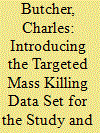

|
|
|
|
|
| Summary/Abstract |
This article describes a new data set for the study of genocide, politicide, and similar atrocities. Existing data sets have facilitated advances in understanding and policy-relevant applications such as forecasting but have been criticized for insufficient transparency, replicability, and for omitting failed or prevented attempts at genocide/politicide. More general data sets of mass civilian killing do not typically enable users to isolate situations in which specific groups are deliberately targeted. The Targeted Mass Killing (TMK) data set identifies 201 TMK episodes, 1946 to 2017, with annualized information on perpetrator intent, severity, targeted groups, and new ordinal and binary indicators of genocide/politicide that can serve as alternatives to existing measures. Users are also able to construct their own indicators based on their research questions or preferred definitions. The article discusses the concept and operationalization of TMK, provides comparisons with other data sets, and highlights some of the strengths and new capabilities of the TMK data.
|
|
|
|
|
|
|
|
|
|
|
|
|
|
|
|
| 7 |
ID:
141179
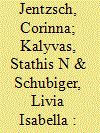

|
|
|
|
|
| Summary/Abstract |
Militias are an empirical phenomenon that has been overlooked by current research on civil war. Yet, it is a phenomenon that is crucial for understanding political violence, civil war, post-conflict politics, and authoritarianism. Militias or paramilitaries are armed groups that operate alongside regular security forces or work independently of the state to shield the local population from insurgents. We review existing uses of the term, explore the range of empirical manifestations of militias, and highlight recent findings, including those supplied by the articles in this special issue. We focus on areas where the recognition of the importance of militias challenges and complements current theories of civil war. We conclude by introducing a research agenda advocating the integrated study of militias and rebel groups.
|
|
|
|
|
|
|
|
|
|
|
|
|
|
|
|
| 8 |
ID:
165451
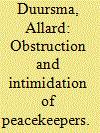

|
|
|
|
|
| Summary/Abstract |
While recent research focuses on why conflict parties attack peacekeepers, little attention has been given to other types of resistance against peacekeeping missions, such as intimidation and obstruction. It is argued in this article that one reason why peacekeepers are obstructed and intimidated is that armed actors that target civilians want to maintain the operational space to carry out attacks against civilians and want to prevent peacekeepers from monitoring human rights violations. A spatially and temporally disaggregated analysis on resistance against peacekeepers in Darfur between January 2008 and April 2009 indeed suggests that the intimidation and obstruction of peacekeepers is more likely to take place in areas with higher levels of violence against civilians. The findings hold when taking into account the non-random occurrence of violence against civilians through matching the data. Finally, anecdotal evidence from other sites of armed conflict than Darfur suggests that resistance against peacekeepers in these cases is also likely to be related to the targeting of civilians. This suggest that in order to be effective in protecting civilians, peace missions should not only be robust as highlighted in previous research, but peace missions should also develop an effective strategy to deal with armed groups that try to prevent peacekeepers from fulfilling their mandate.
|
|
|
|
|
|
|
|
|
|
|
|
|
|
|
|
| 9 |
ID:
157907


|
|
|
|
|
| Summary/Abstract |
Previous research demonstrates that refugee populations can threaten the security of receiving countries. This study, in contrast, seeks to examine the physical security challenges refugees face in host states. It utilizes a new, geographically referenced data set on subcountry refugee demographics to test the hypothesis that locations home to larger refugee populations are more likely to experience one-sided attacks by conflict actors. Results demonstrate that refugee accommodation is a significant predictor of one-sided violence in Africa. In particular, combatants commit significantly more acts of violence against civilians in locations home to larger numbers of self-settled refugees compared to other locations. These findings suggest that scholars and practitioners account for possible dangers presented by refugee flows and threats to refugees simultaneously.
|
|
|
|
|
|
|
|
|
|
|
|
|
|
|
|
| 10 |
ID:
177015
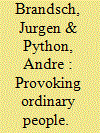

|
|
|
|
|
| Summary/Abstract |
Research on the effects of terrorism mostly focuses on the coercive effects of violence on the macrolevel, while other effects like provocation, particularly on the microlevel, do not receive the same attention. In this article, we seek to address previous omissions. We argue that terrorism can provoke ordinary people into a violent reaction. By reducing perceived security and creating a desire for revenge terrorism may lead civilians to attack uninvolved members of the terrorists’ constituency. Using geo-referenced data on terrorism (Global Terrorism Database) and violent riots (Social Conflict Analysis Database), we assess with a matched wake analysis if the treatment of terrorist violence against civilians causes an increase in violent behavior. The results of our analyses show that terrorism significantly increases violent riots. We thus conclude that terrorism can not only provoke governments but also civilians into an overreaction.
|
|
|
|
|
|
|
|
|
|
|
|
|
|
|
|
| 11 |
ID:
172832
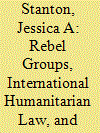

|
|
|
|
|
| Summary/Abstract |
Do rebel group violations of international humanitarian law during civil war—in particular, attacks on noncombatant civilians—affect conflict outcomes? I argue that in the post-Cold War era, rebel groups that do not target civilians have used the framework of international humanitarian law to appeal for diplomatic support from Western governments and intergovernmental organizations. However, rebel group appeals for international diplomatic support are most likely to be effective when the rebel group can contrast its own restraint toward civilians with the government's abuses. Rebel groups that do not target civilians in the face of government abuses, therefore, are likely to be able to translate increased international diplomatic support into more favorable conflict outcomes. Using original cross-national data on rebel group violence against civilians in all civil wars from 1989 to 2010, I show that rebel groups that exercise restraint toward civilians in the face of government violence are more likely to secure favorable conflict outcomes. I also probe the causal mechanism linking rebel group behavior to conflict outcomes, showing that when a rebel group exercises restraint toward civilians and the government commits atrocities, Western governments and intergovernmental organizations are more likely to take coercive diplomatic action against the government. The evidence shows that rebel groups can translate this increased diplomatic support into favorable political outcomes.
|
|
|
|
|
|
|
|
|
|
|
|
|
|
|
|
| 12 |
ID:
143110
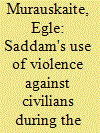

|
|
|
|
|
| Summary/Abstract |
This article explores the drivers behind Saddam Husayn's decisions to target civilians during the Iran-Iraq War. Comparing the intensity and casualty rates of Saddam's counter-city campaigns, the study asks whether their variation was linked to Iraqi battlefield performance, the type and intensity of Iranian offensives, or international attention to the matter. Analysis is based on Saddam Husayn's taped conversations with his advisers, media reports from the period, and public records from Saddam's 2004 interrogation sessions.
|
|
|
|
|
|
|
|
|
|
|
|
|
|
|
|
|
|
|
|
|